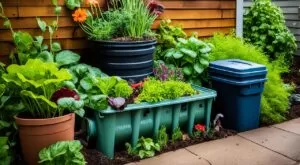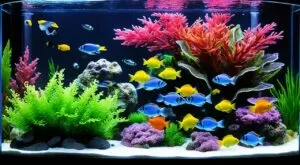NASA found that common indoor plants can fight indoor air pollution and sick building syndrome. Some houseplants are great at cleaning the air, removing pollutants like formaldehyde, benzene, and trichloroethylene. These plants can make the air in your home healthier.

Key Takeaways
- NASA’s 1989 study identified popular houseplants like English Ivy and Bamboo Palm as effective in removing toxic chemicals from the air.
- Experts recommend having at least two plants per 100 square feet to decorate and purify indoor spaces.
- The Rubber Tree, Snake Plant, and Calathea Pinstripe are among the top air-purifying houseplants.
- Chrysanthemums and Chinese Evergreens are also excellent choices for improving indoor air quality.
- Formaldehyde, the most prevalent indoor toxin, can be effectively removed by many of these air-purifying plants.
The Importance of Air-Purifying Plants
Today, we worry a lot about the air inside our homes and offices. The Environmental Protection Agency says indoor air is often 2-5 times dirtier than outside air. Since we spend about 90 percent of our time indoors, having plants that clean the air is key to staying healthy.
NASA’s Clean Air Study and Its Findings
In 1989, NASA scientist Bill Wolverton showed how houseplants can fight indoor pollution. His study looked at 12 common plants and found they’re great at removing harmful substances like formaldehyde and benzene from the air. This research proves that adding air-purifying plants to our homes is a smart move to improve indoor air quality.
The study recommended having at least two big air purifying plants per 100 square feet for best results. Some plants, like the Snake Plant, can grow up to 12 feet tall, cleaning more air. Other top plants for clean air include the Spider Plant, Peace Lily, and Chrysanthemum, each with special air-cleaning powers.
By putting these healthy home plants in our homes and offices, we can make cleaner, fresher air. The NASA clean air study motivates us to use nature to make our indoor spaces healthier.
Best Plants for Purifying Indoor Air
Creating a healthier indoor space means choosing the right plants. These best plants for purifying indoor air are not just pretty. They also clean the air by removing toxins and improving air quality.
A 1989 NASA study found that household plants can fight indoor air pollution. Air-purifying plants take in carbon dioxide and pollutants through photosynthesis. This makes the air cleaner.
Here are some top indoor air purifying plants for your home or office:
- Spider Plant: Effective at removing formaldehyde, xylene, and toluene.
- Snake Plant: Eliminates formaldehyde, benzene, xylene, toluene, and nitrogen oxides.
- Peace Lily: Removes formaldehyde, benzene, trichloroethylene, xylene, and ammonia.
- Aloe Vera: Purifies the air by removing formaldehyde and benzene.
- Boston Fern: Excellent at removing formaldehyde and xylene.
- English Ivy: Efficiently removes formaldehyde, benzene, and trichloroethylene.
- Rubber Plant: Particularly good at removing formaldehyde indoors.
- Golden Pothos: Effective at removing formaldehyde, benzene, and xylene.
- Bamboo Palm: Efficiently removes formaldehyde, benzene, trichloroethylene, and xylene.
- Dracaena: Adept at eliminating formaldehyde, xylene, and toluene.
- Areca Palm: Removes indoor air toxins and adds humidity to the air.
- Gerbera Daisy: Effective at removing volatile organic compounds (VOCs).
- Philodendron: Capable of removing formaldehyde and benzene.
- Weeping Fig: Thrives in bright indirect light and removes various pollutants.
- Chinese Evergreen: Tolerates low light and effectively removes toxins from indoor air.
When picking air-purifying houseplants, think about their light, water needs, and how big your space is. With the right top plants for clean air, you can make your home or office healthier and more oxygen-rich.
Benefits of Indoor Plants Beyond Air Purification
Indoor plants are more than just air purifiers. They bring many benefits beyond clean air. They can make you feel better, think more creatively, and make spaces more welcoming.
These plants help control humidity, making the air feel just right. They also make rooms look nicer, bringing in a touch of nature. This can help lower stress and make you feel more relaxed.
Research shows that having plants at work can make you more productive and creative. Being around nature helps your mind work better and stay focused. At home, plants can help reduce anxiety and make you feel calmer, creating a healthier home.
Indoor plants are great for your mental health and can make your home healthier. By adding plants for indoor air quality and well-being, you can turn your space into a place of peace and creativity.
Selecting the Right Air Purifier Plants
Choosing air-purifying plants for your home involves a few key steps. Make sure the plant fits the room’s size, as bigger plants work well in large areas. It’s also vital to check the light levels in your space, as plants need different amounts of light.
Factors to Consider
The size of the plant affects how well it cleans the air. The NASA Clean Air Study found some plants are better at removing harmful substances from the air. To fully clean a room, you might need up to ten plants per square foot, says National Geographic.
If you have pets, pick plants that are safe for them. Boston ferns, aloe vera, chrysanthemums, and peace lilies are good choices. These plants help keep your home and pets healthy.
Adding air-purifying plants to your office can make it cleaner and more productive. Think about the light, space, and plant needs when picking the best plants for your space.
| Plant | Air-Purifying Capacity | Pet-Friendly |
|---|---|---|
| Boston fern | Excellent | Yes |
| Aloe vera | Excellent | Yes |
| Chrysanthemum | Excellent | Yes |
| Peace lily | Excellent | Yes |
| Snake plant | Good | Yes |
| English ivy | Excellent | No |
| Golden pothos | Excellent | No |

Caring for Your Air-Purifying Plants
Keeping your air-purifying plants healthy is key to their effectiveness. They need the right amount of water, good soil, and balanced food. These are important for their growth and air-cleaning abilities.
Each air-purifying plant has its own watering needs. Some, like the Spider Plant and Peace Lily, need more water. Others, such as the Snake Plant and Aloe Vera, do well with less. Watch the soil and look at the plants to know when to water them.
Choosing the right soil is also vital. These plants like soil that drains well and has nutrients. Stay away from dense soils that can cause waterlogging and root rot.
Feeding your plants the right amount of food is important too. A gentle plant food every few weeks helps them stay green and clean the air. But, don’t overfeed them to prevent too much growth and problems.
It’s important to keep the humidity and temperature right for your plants. Most do well in moderate humidity and temperatures between 65°F and 75°F. Place them in a bright, draft-free spot for the best conditions.
By following these care tips, your air-purifying plants will stay healthy and keep your indoor air clean. With a little attention, they can thrive and offer many benefits.
| Air-Purifying Plant | Key Care Requirements |
|---|---|
| Spider Plant | Moderate watering, well-draining soil, moderate humidity |
| Peace Lily | Consistent watering, moist soil, moderate humidity |
| Snake Plant | Infrequent watering, well-draining soil, low humidity |
| Aloe Vera | Infrequent watering, well-draining soil, low humidity |
| Dracaena | Moderate watering, well-draining soil, moderate humidity |
Maintenance and Propagation Tips
Keeping your air-purifying indoor plants healthy is key to their effectiveness. It involves steps like potting, repotting, watering, and fertilizing. These actions help your plants thrive and keep the air clean.
Keeping Your Plants Healthy
Here are some tips to keep your air-purifying plants in top shape:
- Potting and Repotting: Move your plants to a new pot every 12-18 months. Use a mix that drains well and suits the plant type. This gives them the nutrients and room they need.
- Watering: Water your plants as needed, avoiding too much water which can cause root rot. Always check the soil first to get it right.
- Fertilizing: Feed your plants with a weak, balanced liquid fertilizer every 2-3 months when they’re growing. This helps them grow strong and keep the air clean.
- Pruning: Cut off any dead or damaged leaves or stems regularly. This encourages new growth and better air cleaning.
By following these tips, your air-purifying plants will stay healthy and keep the air in your home or office clean.
Propagating Indoor Plants
Propagating your plants is a great way to grow more and share with others. Here are some common methods:
- Stem Cuttings: Take 4-6 inch cuttings from the plant, remove lower leaves, and put them in a mix that drains well or water them to start roots.
- Division: Split the roots of plants like peace lilies or snake plants carefully. Make sure each part has enough roots and leaves.
- Offsets: Take the offsets or “pups” from plants like bromeliads or succulents and pot them up.
By propagating your plants, you can maintain air purifying plants, propagate indoor plants, and expand your plant collection. This way, you enjoy the many benefits of having healthy, air purifying plants.
| Plant | Air Purifying Ability | Propagation Method |
|---|---|---|
| Aloe Vera | Removes formaldehyde | Leaf cuttings, offsets |
| Peace Lily | Removes benzene, formaldehyde, and trichloroethylene | Division |
| Snake Plant | Removes benzene, formaldehyde, trichloroethylene, xylene, and toluene | Leaf cuttings, division |
Conclusion
Adding the best air-purifying plants to your home can make the air cleaner and healthier. These plants act like natural air filters. They also make your space look better and improve your well-being.
These plants help fight indoor air pollution. They can also make you feel happier and more productive. Plus, they bring the beauty of nature inside.
The Clean Air Study by NASA and new air purification tech help you choose the right plants. With these air-purifying houseplants, you can clean indoor air naturally. This makes your home a healthier place.
By picking these best plants for purifying indoor air, you’re making your living space better for you and the planet. It’s a smart move for your health and the environment.
Start making your home or office healthier with these air-purifying plants today. Your lungs and overall health will be grateful.
FAQ
What is the best way to improve indoor air quality?
NASA research suggests using houseplants as a natural way to fight indoor air pollution. These plants are great at removing pollutants from the air.
What are the top air-purifying plants recommended by NASA?
NASA’s Clean Air Study found many indoor plants that clean the air well. These include Spider Plant, Snake Plant, Peace Lily, Aloe Vera, Boston Fern, English Ivy, Rubber Plant, Golden Pothos, Bamboo Palm, Dracaena, Areca Palm, Gerbera Daisy, Philodendron, Weeping Fig, and Chinese Evergreen.
What are the additional benefits of having indoor air-purifying plants?
Indoor plants do more than clean the air. They make people feel better, increase creativity, and improve well-being. They also make spaces look nicer and help control humidity.
What factors should be considered when choosing air-purifying plants?
Think about the size of the plant and the room, the light it needs, and if it’s safe for pets. This helps pick the right plants for your space.
How do I properly care for my air-purifying plants?
Take care of your plants by watering, feeding, and keeping the right humidity and temperature. This keeps them healthy and effective at cleaning the air.
How can I sustain the air-purifying benefits of my plants over time?
Keep your plants clean and healthy by following care tips. This includes repotting, choosing the right soil and food, and fixing common problems.





